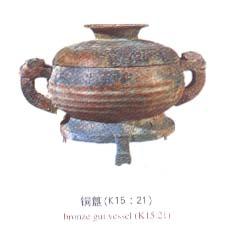1) Sacrifice culture


祭祀文化
1.
Sacrifice culture was the most dominant content of Confucians Rite culture and sacrifice was an important part of academy education and instruction.
祭祀文化是儒家礼制文化最重要的内容之一,祭祀是书院教育的一个重要组成部分。
2) sacrificial culture


祭祀文化
1.
The paper firstly introduces the comparative study situation of sacrificial culture between the Book of Songs and Chuci and the significance.
本文在绪论部分介绍了《诗经》与《楚辞》祭祀文化比较研究的现状和意义所在。
3) sacred sacrifice culture


宗教祭祀文化
4) sacrificial rites


祭祀
1.
On the base of campestral investigation,the author mainly studies the characteristics and relations between Fengshui and sacrificial rites on the old lounge bridges in the east of Fujian province,and points out that the appearing signal of the old lounge bridges mixed together the bridges and the local village culture by means of their formal signal and their symbolic expression.
在田野调查的基础上,主要考察闽东廊桥在风水与祭祀两个方面的种种表征,指出廊桥凭借自身外显的形式符号,借助象征语言将桥梁与村落文化融为一体;廊桥既具现实的利民渡涉的作用,又反映了闽东乡民观念中的趋福避祸的心理,具有丰富的文化内涵。
2.
The words in Chuci come from the sacrificial rites of the chief of a tribe in the region of Yuan river or Xian river.
《九歌》是一组具有国家祀典性质的祭歌,用于大型、重要的祭祀活动。
3.
With historical development,ethnic Manchu developed into four social groups,who lived in different from each other geographical and cultural conditions,and thus their sacrificial rites underwent different changes in content and form.
不同类型的满族群体在相异的地理环境和文化的影响下 ,其民间祭祀的内容和形式也发生了不同的变化 ,表现出满族民间祭祀的稳定性和变更性相统一的文化特点。
5) fete
[英][feit] [美][fet]


祭祀
1.
In Mongolian areas Tibetan Buddhism penetrated into the people s social and daily lives,and brings great changes to Mongolian folklore,especially in funeral and fete customs.
其中佛教观念对卫拉特人的丧葬和祭祀习俗影响格外深远,体现在埋葬方式、丧葬礼仪以及对大自然、佛和各种神的祭祀等方面。
2.
The paper studied the relation between the Manchu shamanism and fete through Eight Banners genealogy.
本文运用八旗谱牒资料,对萨满教与祭祀之间的关系展开研究。
6) worship
[英]['wɜ:ʃɪp] [美]['wɝʃɪp]


祭祀
1.
Based upon an examination of the early Ming state worship objectives and the later changes,this article argues that this system carries profound religious,cultural,political,and social implications.
明代国家祭祀对象的构成及其变化表明,该体系具有宗教、文化、政治、社会等多重寓意。
2.
It concludes that the reformis derivedfromthestruggle between“idealist”and“conventionalist”is groundless ;the practice of worshipingthe“heavenly deities”and“earthly deities”does not actually create two kinds of city gods ;the so calledthird year“reform”has little todo withthe Ming policies towards Taoism;the regulations issuedinthe third year of the H.
文章针对日本学者滨岛敦俊关于洪武三年城隍祭祀“改制”的三篇论文指出:所谓改制背景为“理念派”与“惯习派”之争说法出于虚构;洪武三年二月份祀天神、地礻氏并未造成“两种城隍”;洪武三年“改制”与明朝对道教的政策无关;洪武三年所定祭祀城隍规则曾得推行,后来才发生变化。
3.
The oracle inscriptions discovered in Yin Remains have records of Yin people worshiping Shang and Huan Rivers.
殷墟卜辞曾多次记载殷人祭祀滳水、洹水。
补充资料:河南新郑郑韩故城郑国祭祀遗址

河南新郑郑韩故城郑国祭祀遗址
时代:春秋
发掘地点:河南省豫西山地和豫东扇积平原的交接地带
发掘单位:河南省文物考古研究所
简介:
河南省新郑市郑韩故城是东周时期郑国和韩国的都城,郑国祭祀遗址位于郑韩故城东城西南面,总面积20000平方米,遗址清理出土春秋时期郑国青铜礼乐器坑17座,殉马坑44座、夯土墙基一道,商周灰坑791座,水井98眼,战国烘范窑3座,小型墓葬80座,瓮棺葬28座,两周及汉代灶坑9座,还有一批战国牛肋骨墨书文字从出土。发现了以348件郑国公室青铜礼乐器大都保存完好,精美富丽,件套完整,编钟、编镈138件,多经调音,为实用乐器。此次发掘大大丰富了对春秋时期礼乐制度、郑国铜器等方面的认识。郑韩故城郑国祭祀遗迹的发掘为研究战国文字和仓廪管理制度提供了难得的实物资料。对我国春秋时期的礼乐制度、古乐器学、考古音乐学、乐律史、音乐史和科学技术史等方面的研究,均具有非常重要的价值。
说明:补充资料仅用于学习参考,请勿用于其它任何用途。